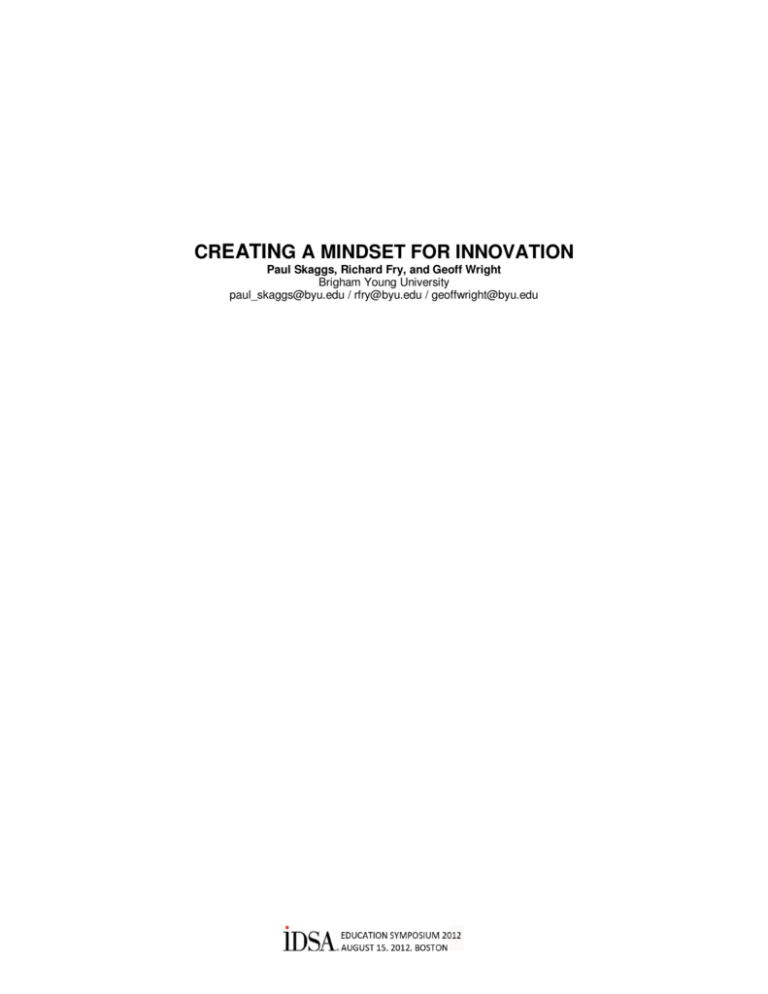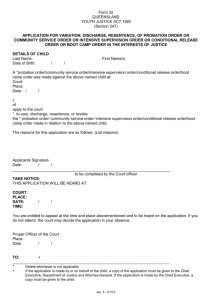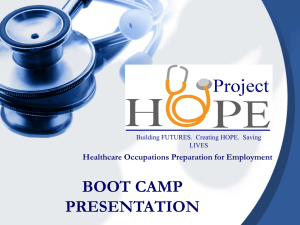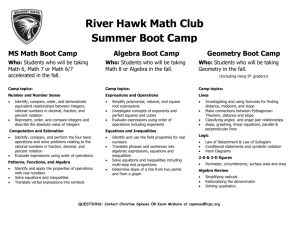CREATING A MINDSET FOR INNOVATION
advertisement

CREATING A MINDSET FOR INNOVATION Paul Skaggs, Richard Fry, and Geoff Wright Brigham Young University paul_skaggs@byu.edu / rfry@byu.edu / geoffwright@byu.edu BACKGROUND In 1999 the Industrial Design program at Brigham Young University moved from the College of Visual Arts to the College of Engineering and Technology. This move was motivated by new synergies developing in industry between engineering, manufacturing and industrial design. The move would help industrial design students to understand and take full advantage of these growing opportunities for collaboration. The move has had a positive impact on the design program and the students. One of the strongest and most impactful collaborations has been the development of an Innovation Boot Camp. The College of Engineering and Technology had developed a series of strategic initiatives, one of those initiatives being innovation, but was unsure how to move forward on the initiative. The director of the School of Technology recognized an opportunity to help create a mindset for innovation in the College of Engineering and Technology leveraging School of Technology resources, primarily Industrial Design. There was an innovation committee formed in the School of Technology consisting of 5 professors from various interested programs in the school. The innovation committee, through literature review and site visits to other universities and companies promoting innovation, defined a number of methodologies for teaching innovation. One of the methods devised was the development of an Innovation Boot Camp. The curriculum for the boot camp was built off of a “Creativity and Design Thinking” course taught in the industrial design program. This curriculum was augmented by information gathered from site visits to Stanford, Rochester Institute of Technology, Penn State, IDEO, and a fairly extensive literature review on the subject of creativity, innovation, and problem solving. The innovation experience was then refined and defined as a number of core principles that the committee felt were most important to communicate to the students. Those principles being; Human Centered, Safe Environment, Interdisciplinary, Makes Ideas Concrete, and Aware of the Ingredients, those ingredients being: (1) Understanding through the activities of Observation, Experience, and Inquiry; (2) problem Shaping by Organizing, Simplifying, and Clarifying; (3) broad divergent Exploration through activities of Point of View, Association, and Combination; (Davidson, 1994) (4) problem Refining by Visualizing, Validating, and Iterating; and (5) Sharing insight using the activities of Show, Demonstrate and Describe. The concept of an Innovation Boot Camp was determined to be a good methodology to teach and apply the outlined innovation principles. The Innovation Boot Camp was originally defined as a two day, rigorous, hands-on, interdisciplinary workshop focused on giving students opportunities to apply principles of innovation on discovered problems. The boot camp would blend students and faculty from 4 different programs from the College of Engineering and Technology. PURPOSE The purpose of this paper is to share our definition of innovation, describe the selected principles and to share the development of the boot camp curriculum, organization, activities and methods of instruction. Additionally, the paper will outline the learning outcomes and the relative impact the Boot Camp is having on student understanding of innovation principles and be able to apply them and how the experience is informing our college’s initiative to create a culture of innovation. The goal is the adoption and commitment to explicitly teach and provide students with innovation learning experience. However, the plausibility of a college-wide buy-in and adoption is questionable due to the college’s deeply traditional academic approach to teaching engineering and technology. The effort required to change this culture requires school administrators and professors to spend a significant amount of time, separate from their normal teaching, research, and service loads, as well as provide additional funding for the experience. Consequently, this research study not only adds significantly to the theoretical underpinnings of innovation and creativity pedagogy, it also provides insight as to the needs and benefits of such an endeavor. To understand the influence of the Innovation Boot Camp experience on the students and college, information was gathered throughout the entire boot camp experience, including the curriculum development, instructional methods, and validation at the conclusion of the boot camp. The summative evaluation efforts have included an online survey, a focus group interview session, and one-on-one follow-up interviews. PROBLEM STATEMENT Kleppe (2001) notes that, dating from the late 1700s to the modern day, “a major source of technological advancement has been the result of individual inventors [and] innovations” (p. 16). Surprisingly, most technology and engineering programs in the United States do not explicitly teach innovation (Smoot, 2006). With the increasingly complex and competitive global market, and with new interest and concern over environmental issues, biotechnologies, and so forth, many companies are reforming how and where they do business. Additionally, many academic institutions are calling for a “radical restructuring of the theoretical knowledge taught in academic education programs . . . in order to create competencies of professional value in today’s business situations” McAloone, (2007). In order to address the many challenges involved with the new global industrial arena, many technology educators believe the theoretical restructuring that needs to take place must involve and center on innovation. Kleppe (2001) Despite the need to include innovation as a key component of technology and engineering curriculum, some universities have made restructuring efforts to include aspects of innovation. A study done by the Southern Technology Council found that there are very few universities supportive of educational initiatives that teach innovation. The lack of support and inclusion of innovation in technology and engineering-related programs seems to stem from archaic mathematics and science curriculum standards, as well as outdated technology and engineering curriculum standards. Although engineering programs have existed and been taught for well over sixty years at the university level, most of the courses and degrees have focused on traditional engineering concepts (i.e., hard math and sciences) and have not bridged into the areas of creativity and innovation. It has only been in the last five years that universities have started to recognize creativity and innovation as a key component of engineering (Courter, 2006). In light of the need to ensure that students are ready for the challenges of our global economy, technology and engineering educators need to ensure that we are continuing to evolve our practices and curriculum, which would demand the inclusion of innovation as a key component of technology and engineering curriculum. METHOD With the economic need and acceptance for outsourcing, as well as competition in areas such as global product development, many American engineering and technology institutions are rethinking and restructuring the content and instruction of engineering and technology curriculum (McAloone, 2007). In an effort to address this issue, our college has established several school-wide technology and engineering initiatives that focus on the issues of leadership, global awareness, and innovation. College administrators established a committee to investigate ideas on how to promote innovation. The innovation committee travelled to several institutions recognized internationally for their exemplary models of innovation and performed a literature review on the subject of innovation and its various related topics. Through the research innovation was refined and defined as “unique and useful ideas successfully implemented”. This led to an innovation model described as the “ice cream cone” model (see fig. 1). The model pairs strategic divergent, problem finding to develop unique and useful insights with convergent, problem solving to implement ideas successfully. The conclusion was that the later, implementation, was taught pretty well in the college so the focus of the innovation committee was to teach the divergent, problem finding, strategic part of innovation. In addition to the divergent problem finding ingredient it was determined that a number of other important principles needed to be incorporated including; insights should be human centered, a safe environment where critique and comments would be accepted as positive and productive, the value of interdisciplinary approach to see insights from numerous points of view and perspectives, and tools to make ideas concrete so all in the group could understand the insights at a higher level. Figure 1. Ice Cream Cone Model of Innovation A number of ideas were proposed for advancing innovation in the college. One of the ideas the innovation committee developed to make a positive impact on student innovation ability was to institute an Innovation Boot Camp. In short, the boot camp was developed as an intensive, innovation-focused workshop that would immerse students in an experiential collaborative learning environment that would require them to work in teams with students from various programs housed within the college in order to identify and solve problems using principles of innovation. There are three phases to this research project: (1) developing and implementing the Innovation Boot Camp, (2) evaluating the Innovation Boot Camp experience, and (3) assessing and restructuring the Innovation Boot Camp. DEVELOPMENT AND IMPLEMENTATION An innovation committee was formed comprised of professors from a number of school programs. The basic curriculum was taken from a class on “Creativity and Design Thinking” taught in the Industrial Design program. This curriculum was modified and enlarged using data collected from their observations during their visits to the various well-known innovation institutions, and from creativity and innovation literature. This information was used to formulate several ideas for creating and implementing the desired innovative culture in the school. Various ideas were put forth, though it was ultimately decided that an experiential workshop highlighting the key principles of innovation would be the fastest and more impactful method to initiate. This workshop came to be known as the Innovation Boot Camp. The first boot camp was taught in March of 2008 by three of the industrial design faculty with a group of student and faculty volunteers from the number of programs in the college. The boot camp has gone through numerous modifications including being offered for two terms as a block class (7 weeks, 1 day a week) but has since reverted back to a two-day boot camp experience. Currently the boot camp experience is in its 18th iteration, has a dedicated space, and is a required course in 4 programs in the college. The boot camp experience starts with 25 students, these students are split into 5 interdisciplinary groups of 5 students each, participating faculty members are put in their own group so as to allow the students freedom from the influence of any authority figures. Faculty members are encouraged to attend to learn the principles so as to be able to reinforce them in subsequent classes. On day one, students are introduced to the need and idea of innovation, leading the students to establish a working definition of the term. Students were then introduced to the five key principles of innovation and they engage in one experiential activity per principle—an approach that served as a tactical opportunity to semantically apply the principles. The next activity was to combine all the principles on a single problem opportunity where each activity built upon the previous, thereby helping the students transfer and scaffold their learning from principle to principle. By the end of the day, the students had developed an innovative insight about a product or system as a result of their collaborative efforts through the whole innovation principles activity. To conclude the first day, each group of students shared the insights they identified and the innovative proposal they developed as a result of employing each principle of innovation. At the conclusion of their presentations, they were introduced to a capstone activity that would require them to go through the steps of innovation one additional time. The students were expected to continue to work in their teams to ready themselves for the capstone presentation and evaluation. The purpose of the capstone experience was to evaluate whether or not the students understood the innovation principles well enough to combine them in pursuit of developing tools they could use to identify problems and develop unique and useful insights. Figure 2. Understanding, Shaping as part of problem finding Day two of the Innovation Boot Camp consisted of each group sharing how they worked to understand, shape, explore, define their respective discovered problems, accompanied by a proposal of their capstone projects based on the five key principles of innovation. Representatives of local design and engineering companies and interested professors from the school evaluated the students’ projects based on principles of flexibility, fluency, uniqueness, elaboration and usefulness. EVALUATION At the completion of the boot camp a discussion session was held with the participating students allowing them to share their reflections on the boot camp experience. They were encouraged to determine whether or not their experience helped them to develop and learn innovation skills; they were also asked to defend their opinions. Exit surveys were emailed to each student at the conclusion of the boot camp in anticipation that the students would complete the survey within the first few days following the experience. Additionally, several students were randomly selected to participate in a focus-group exit interview. The first boot camp was filmed and later used to critique and analyze the attentiveness and participation of the students. The instructors of the boot camp were also invited to watch the video to help evaluate their instructional methods and the associated activities and content. Two outside observers from the college were also invited to view the film and asked to take notes on what was done, how they perceived the instruction was being received, how the activities were helping the students understand the principles and concept of innovation, how the students seemed to enjoy or not enjoy the experience, and so forth. A few of the key themes from the evaluations are as follows. Overall survey results and interviews (n = 54) stated that 100% of the students reported their belief that the Innovation Boot Camp should be continued, and 71% of the students (n = 54) identified their time spent at the boot camp as Effective on a scale that included Ineffective, Not Very Effective, Moderately Effective, Effective, and Very Effective. When the students were asked to rate on a 1–5 scale (5 being high) how the Innovation Boot Camp influenced their understanding of innovation, the mean was 4.0, the variance was 1, and the standard deviation was 1. When the students were similarly asked to rate how they believed their propensity for innovation to have been influenced by the camp, 43% responded that it made a significant amount of difference. Then, when the students were asked to rate how they believed their skills related to innovation were influenced by the boot camp experience, 86% reported that they believed their skills to have been significantly influenced by the experience. Also, 85% of the students said that they thought their time at the Innovation Boot Camp was spent either effectively or very effectively. The outside observers reported similar findings, and, while they proposed various suggestions, the majority of their thoughts centered on curriculum design issues and content. ASSESSING AND RESTRUCTURING The innovation boot camp is still in the developing, validating and iterating prototype stage of progress. The findings from the surveys, interviews, and qualitative observations have provided helpful insight as to how the innovative boot camp might be restructured and developed. The primary areas of restructuring we have thus far addressed center on curriculum issues. There are numerous principles common among innovation-related literature, and though the principles innately suggest similar concepts, it is important to solidify the vocabulary being used in the Innovation Boot Camp curriculum. There has been an increasing level of interest in the college and across the campus in the Innovation Boot Camp. The question arises how to expand the offering with the limited resources available. In addition, interest has gone beyond the university with numerous requests from corporations to conduct on-site boot camps. Again, this is a resource issue. The development of good assessment tools for the boot camps effectiveness is also an important issue to address. CONCLUSION Although the data is limited as a result of the Innovation Boot Camp’s newness, it has shown strong indicators of having an important impact by preparing our students to be innovative in the globally competitive technology and engineering market. In such a market, innovation is an essential and defining skill. The Innovation Boot Camp will continue to be refined, shared, validated and iterated but assessment has shown that it is having the desired effect by addressing the innovation initiative and of creating a mindset for innovation in the college. REFERENCES Davidson, E., Deuser, R.J. Sternberg (1994) The role of metacognition in problem solving. Cambridge: MIT press Courter, S. (2006). Transforming college teaching courses into authentic experiences: Learning through diversity. Conference Proceedings of the ASEE Annual Conference and Exposition (p. 32). Hansen, J. (2007). Creativity and innovation: Core capabilities for 6–12 engineering teachers. Conference Proceedings of the ASEE Annual Conference and Exposition (p. 16). Kleppe, J.A. (2001). Teaching invention, innovation, and entrepreneurship to Northern Nevada high school science and math teachers. Proceedings of the Frontiers in Education Conference (pp. 16–19). McAloone, T. C. (2007). A competence-based approach to sustainable innovation teaching: Experiences within a new engineering program. Journal of Mechanical Design, 769–778. Smoot, D. C. (2006). Product and process of innovation. Journal of Advanced Materials, 64–79.








